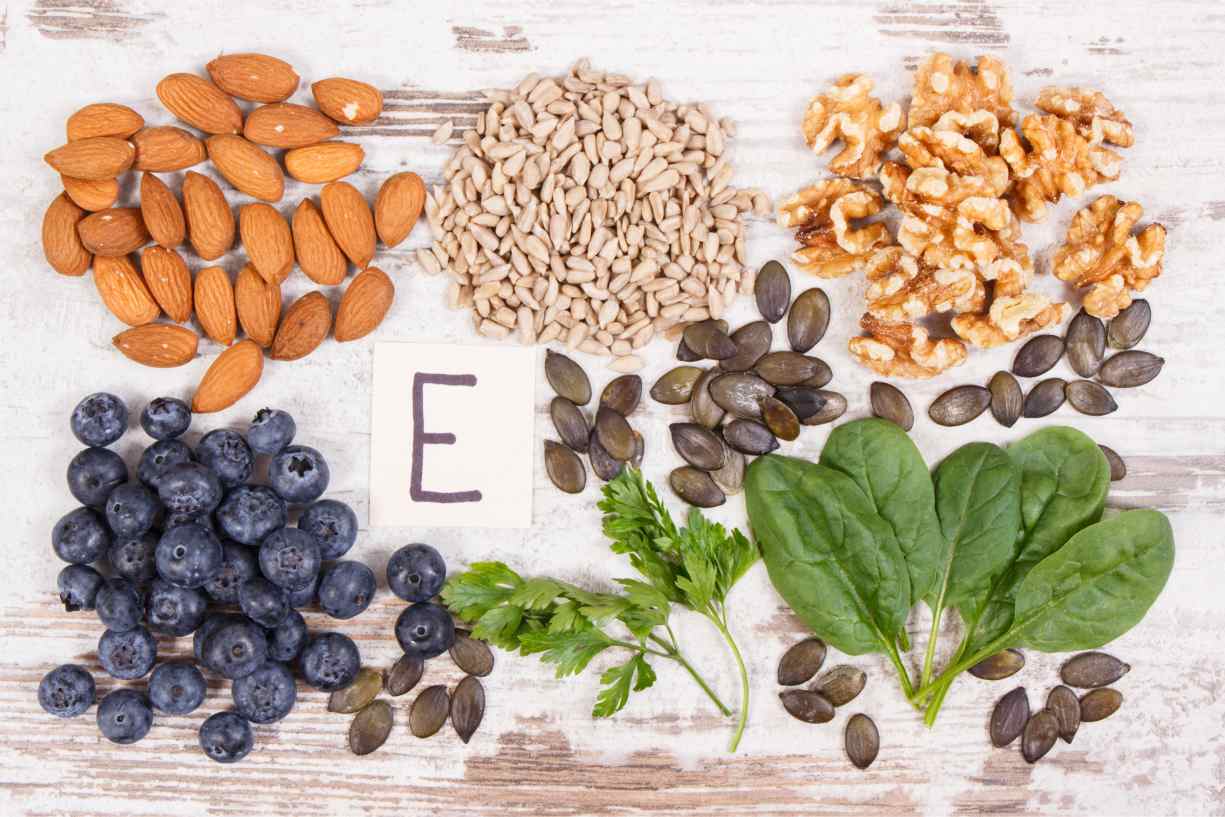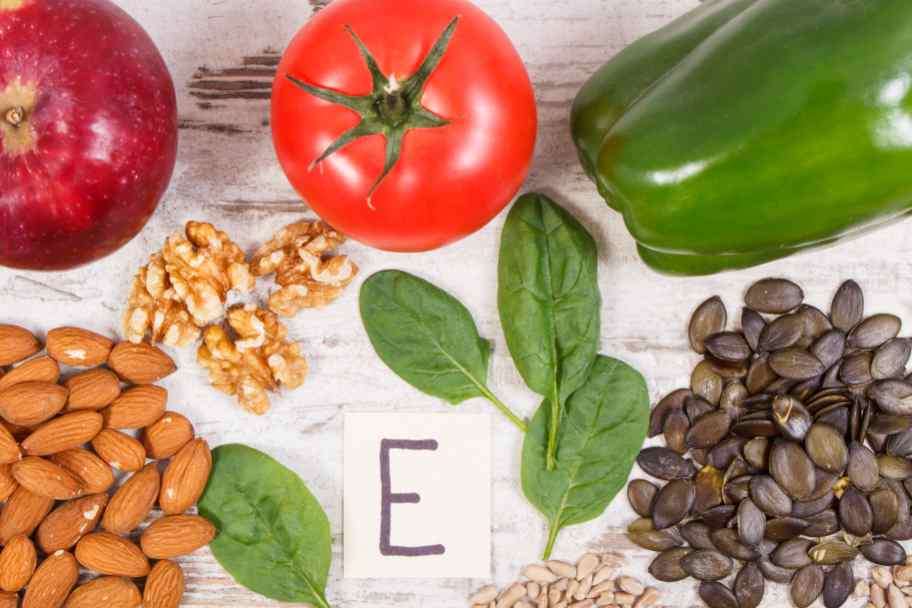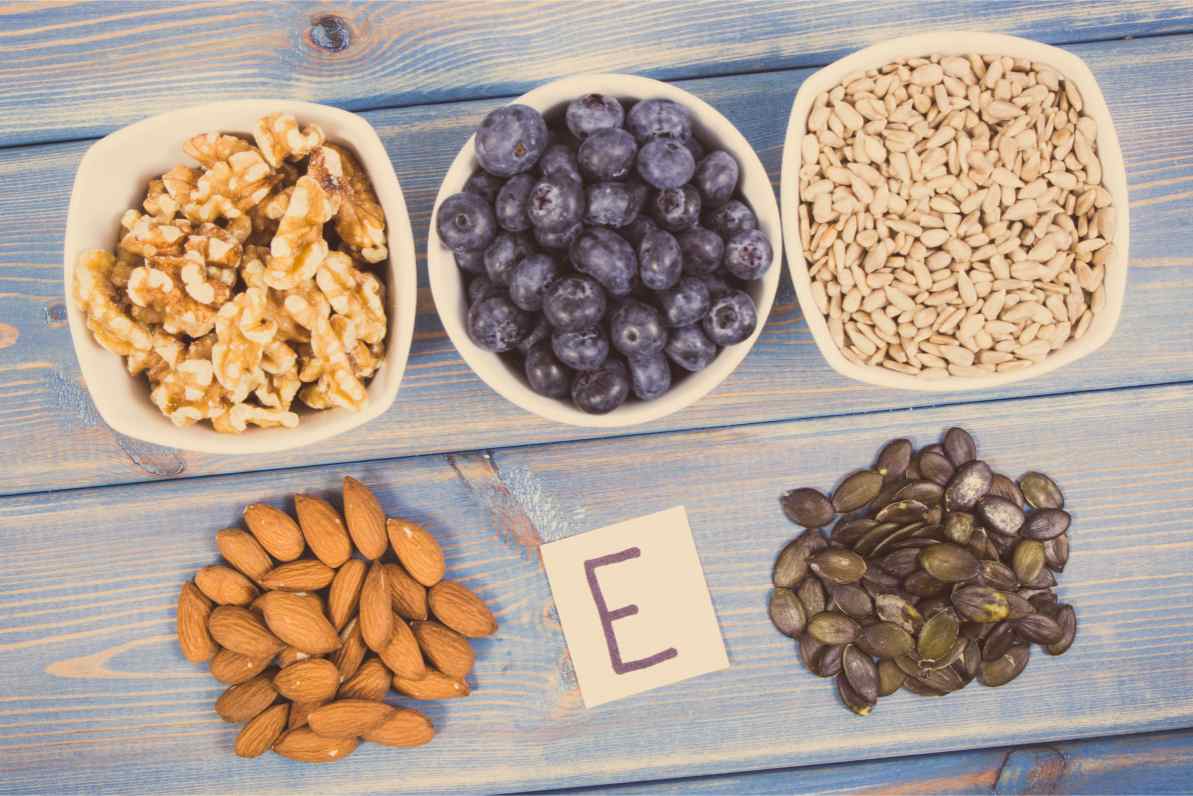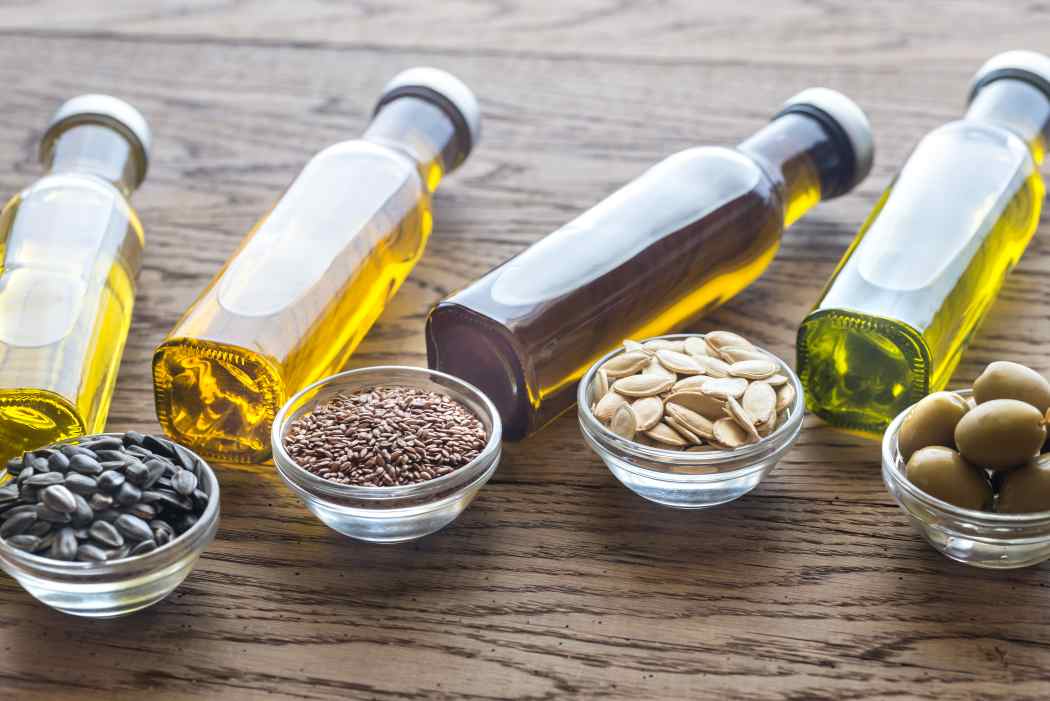69 Vitamin E Rich Foods, Fruits & Vegetables to Include in Your Diet

Modern living is all about simplifying life. Unfortunately, this requirement has given rise to a demand for processed and fried food. The rise of heart disease and obesity is the impact of toxin intake.
Among the vitamin family, the fat-soluble compound vitamin E helps protect the body from cell damage. Hence, it is imperative to include vitamin E rich foods into the diet.
Here is a list of foods that contain vitamin E or alpha-tocopherol. Scroll down to take the first step to a healthy lifestyle.

Table of Contents

What is Vitamin E?
Vitamin E typically refers to alpha-tocopherol succinate. It's an antioxidant that protects cells from damage caused by free radicals. Commonly found in skincare products, dietary supplements, and certain foods, vitamin E promotes skin health, enhances immune function, and supports eye health.
What are the Sources of Vitamin E?
Vitamin E, known as alpha-tocopherol, is found in various foods. Nuts and seeds, like almonds, sunflower seeds, and hazelnuts, are rich sources. Vegetable oils, such as sunflower, safflower, and wheat germ oil, also contain high levels of vitamin E. Leafy green vegetables, including spinach and broccoli, provide vitamin E.
Top 69 Food Items High in Vitamin E
Vitamin E is a vital component found in numerous food items. Here is a list of vitamin E foods to check before preparing a diet.
List of Vegetables Rich in Vitamin E

Green and leafy vegetables are the best sources of nutrients due to their easy availability. Here is a list of vegetables one can check to confirm which food vitamin E is found.
SNo. |
Vegetables | Vitamin E Content (Per 100 grams) |
| 1 | Turnip | 2.9 mg |
| 2 | Collards | 2.3 mg |
| 3 | Spinach | 2 mg |
| 4 | Swiss Chard | 2 mg |
| 5 | Beet Greens | 1.9 mg |
| 6 | Mustard Greens | 1.8 mg |
| 7 | Red sweet pepper | 1.6 mg |
| 8 | Brocolli | 1.5 mg |
| 9 | Asparagus | 1.5 mg |
| 10 | Cabbage | 1.5 mg |
| 11 | Butternut squash | 1.3 mg |
List of Fruits Rich in Vitamin E

Including fruit in breakfast or lunch can fulfil the daily need for nutrients. Therefore, it is imperative to know which fruit has the most vitamin E.
Here are some of India's top vitamin E fruits to try today.
SNo. |
Fruits | Vitamin E Content (Per 100 grams) |
| 12 | Olive | 3.8 mg |
| 13 | Avocado | 2.1 mg |
| 14 | Cranberries | 2.1 mg |
| 15 | Mamey Sapote | 2.1 mg |
| 16 | Kiwi Fruit | 1.5 mg |
| 17 | Blackberries | 1.2 mg |
| 18 | Black currant | 1.0 mg |
| 19 | Mango | 0.9 mg |
| 20 | Apricots | 0.9 mg |
| 21 | Raspberries | 0.9 mg |
List of Seeds and Nuts Rich in Vitamin E

Here is a table listing seeds and nuts rich in vitamin E along with their vitamin E content per 100 grams:
SNo. |
Seeds and Nuts | Vitamin E Content (Per 100 grams) |
| 22 | Sunflower Seeds | 35.17 mg |
| 23 | Almonds | 25.63 mg |
| 24 | Hazelnuts | 15.03 mg |
| 25 | Pine Nuts | 9.33 mg |
| 26 | Peanuts | 8.33 mg |
| 27 | Pistachios | 2.86 mg |
| 28 | Walnuts | 0.70 mg |
| 29 | Pecans | 1.40 mg |
| 30 | Brazil Nuts | 5.65 mg |
| 31 | Cashews | 0.92 mg |
| 32 | Macadamia Nuts | 0.54 mg |
| 33 | Sesame Seeds | 0.25 mg |
| 34 | Chia Seeds | 0.50 mg |
| 35 | Flaxseeds | 0.31 mg |
| 36 | Hemp Seeds | 0.80 mg |
| 37 | Pumpkin Seeds | 0.56 mg |
| 38 | Watermelon Seeds | 0.53 mg |
List of Cooking Oils in Vitamin E

With healthy habits comes a healthy solution. Since obesity and toxin consumption have become health hazards, the demand for vitamin E-rich oils has grown. Here is a list of which oils contain the most vitamin E.
SNo. |
Animal and Seafood | Vitamin E Content (Per 100 grams) |
| 39 | Wheat Germ oil | 149 mg |
| 40 | Hazelnut oil | 47 mg |
| 41 | Sunflower oil | 41 mg |
| 42 | Almond oil | 39 mg |
| 43 | Cottonseed oil | 35 mg |
| 44 | Safflower oil | 34 mg |
| 45 | Rice Bran oil | 32 mg |
| 46 | Grapeseed oil | 29 mg |
| 47 | Canola oil | 18 mg |
| 48 | Palm Oil | 16 mg |
List of Animal Protein and Seafood High in Vitamin E

Here's a table listing animal and seafood sources high in vitamin E, some of the wealthiest animal and seafood sources of vitamin E, useful for those looking to increase their intake of this essential nutrient through non-plant-based foods, along with their vitamin E content per 100 grams:
SNo. |
Animal and Seafood | Vitamin E Content (Per 100 grams) |
| 49 | Atlantic Salmon | 2.8 mg |
| 50 | Rainbow Trout | 2.2 mg |
| 51 | Atlantic Herring | 1.7 mg |
| 52 | Shrimp | 2.2 mg |
| 53 | Octopus | 1.2 mg |
| 54 | Crab | 2.1 mg |
| 55 | Tuna | 0.9 mg |
| 56 | Lobster | 1.6 mg |
| 57 | Mackerel | 1.7 mg |
| 58 | Sardines | 2.0 mg |
| 59 | Halibut | 0.8 mg |
| 60 | Abalone | 2.5 mg |
| 61 | Oysters | 1.7 mg |
| 62 | Chicken (dark meat) | 0.3 mg |
| 63 | Turkey (dark meat) | 0.4 mg |
| 64 | Pork (loin) | 0.3 mg |
| 65 | Duck | 0.5 mg |
| 66 | Goose | 0.6 mg |
| 67 | Beef Liver | 0.7 mg |
| 68 | Lamb Liver | 0.8 mg |
| 69 | Atlantic Salmon | 2.8 mg |
Vitamin E is an essential nutrient that every individual must include in his or her diet. This requirement can be fulfilled by adding a balanced proportion of vitamin E rich foods. Preparing a meal chart with dishes cooked in vitamin E rich oil and vegetables would be beneficial.
How Much Vitamin E Should You Intake?
According to Mayo Clinic, vitamin E is vital for numerous bodily functions, including immune health and skin protection. The recommended daily intake of vitamin E varies by age and life stage. Here’s a table summarising the daily requirements for different age groups:
Age Group |
Recommended Vitamin E Intake (milligrams per day) |
| Birth to 6 months | 4 mg |
| Infants 7–12 months | 5 mg |
| Children 1–3 years | 6 mg |
| Children 4–8 years | 7 mg |
| Children 9–13 years | 11 mg |
| Teens 14–18 years (boys) | 15 mg |
| Teens 14–18 years (girls) | 15 mg |
| Adults (men) | 15 mg |
| Adults (women) | 15 mg |
| Pregnant teens | 15 mg |
| Pregnant women | 15 mg |
| Breastfeeding teens | 19 mg |
| Breastfeeding women | 19 mg |
Ensuring adequate vitamin E intake is essential for overall health. Including a variety of vitamin E rich foods in your diet can help meet these daily requirements.
Role of Vitamin E in Keeping the Body Active
Vitamin E is a combined name for lipophilic compounds with a chromanol ring and a side chain at the C2 position. There are usually four tocotrienols and four tocopherols.
Discovered in the 1980s as a dietary factor to support reproduction, vitamin E is now regarded as a free radical-hunting antioxidant.
It is a fat-soluble compound found in leafy vegetables, nuts, seeds, and certain plant oils like wheat germ. The compound operates as an antioxidant and protects the body from free radicals that damage human cells.
Moreover, vitamin E foods would prevent atherosclerosis and reduce chances of vision loss, cancer and other chronic issues.
Some of the proven benefits of consuming vitamin E rich foods are discussed below.
Consuming vitamin E-rich fruits and vegetables can help prevent diseases such as cardiovascular illness, neurological disorders, age-related eye and skin damage, and infertility.
It helps lower the serum cholesterol levels and simultaneously boosts up the immune responses.
Vitamin E acts as an antioxidant, removing body toxins and scavenging free radicals, such as singlet oxygen and peroxyl radicals.
It is also used for biomedical materials. The component α-Tocopherol is blended into a dialysis membrane of chronic haemodialysis patients to recover stability and functions.
Multiple studies have indicated that taking vitamin E supplements or food can help adults remain mentally active. It also prevents Alzheimer’s disease and the decline of mental health.
Gynaecologists recommend 15 milligrams of vitamin E to pregnant women as it helps develop a baby’s nervous system. While breastfeeding, mothers are advised to increase their intake up to 19 milligrams.
These factors substantiate the need to add vitamin E-rich foods to one’s meal. Some of the food items that can fulfil the requirement are listed below.
Health Benefits of Including Vitamin E Rich Foods
Including vitamin E rich foods in your diet provides numerous health benefits, from protecting cells to boosting immunity. Here are some key benefits:
- Antioxidant Protection: Vitamin E is a powerful antioxidant, protecting cells from damage caused by free radicals. Free radicals are unstable molecules that can cause oxidative stress, leading to cell damage and contributing to ageing and various diseases.
- Immune System Support: Vitamin E enhances immune function, helping the body fight infections more effectively. It does this by stimulating the production of immune cells, such as T-cells, and improving their activity.
- Skin Health: Vitamin E promotes healthy skin by preventing oxidative stress and supporting skin repair. It helps maintain skin elasticity and moisture, reduces the appearance of scars and wrinkles, and can alleviate conditions like eczema and psoriasis.
- Eye Health: Vitamin E reduces the risk of age-related macular degeneration and cataracts, two leading causes of vision impairment and blindness. It protects the cells of the eyes from oxidative damage, slowing down the progression.
- Heart Health: Vitamin E helps maintain heart health by preventing the oxidation of LDL cholesterol, which is a crucial factor in the development of atherosclerosis (hardening and narrowing of the arteries).
- Anti-Inflammatory Properties: Vitamin E has anti-inflammatory effects, which can help reduce the risk of chronic diseases such as arthritis, diabetes, and heart disease. It inhibits the production of inflammatory molecules, thereby reducing inflammation and pain.
- Hormonal Balance: Vitamin E supports hormonal balance and can alleviate symptoms of PMS in women, such as cramps, mood swings, and breast tenderness. It also regulates menstrual cycles and improves reproductive health.
- Cognitive Health: Adequate vitamin E intake is linked to a lower risk of cognitive decline and Alzheimer's disease. It protects neurons from oxidative damage and supports brain function, improving memory and mental performance.
- Muscle Repair: Vitamin E aids in muscle repair and reduces oxidative stress after exercise. It helps recover muscle cells and reduces muscle soreness, improving athletic performance and endurance.
Different Ways to Include Vitamin E Rich Foods in Your Diet
Incorporating vitamin E rich foods into your diet is crucial for overall health, as this antioxidant supports immune function and skin health. Here are various ways to include these nutrient-packed foods in your meals:
Symptoms of Vitamin E Deficiency
Vitamin E deficiency can lead to various health issues due to its role as an antioxidant. Incorporating these foods into daily meals can help prevent vitamin E deficiency and reduce the risk of associated health problems. Symptoms may vary but commonly include:
- Neurological Issues: In addition to muscle weakness and impaired coordination, individuals may experience peripheral neuropathy, leading to numbness or tingling in the extremities.
- Visual Disturbances: Beyond retinal degeneration and loss of vision, night blindness may develop due to vitamin E deficiency affecting the eyes' ability to adjust to darkness. These disturbances can significantly impact daily activities and quality of life.
- Weakened Immune Function: Vitamin E deficiency compromises the immune system's ability to fight off infections, increasing susceptibility to bacterial, viral, and fungal illnesses. Prolonged deficiency can lead to frequent infections, delayed wound healing, and compromised immune response.
- Skin Problems: Dry, rough, and flaky skin is a common symptom of vitamin E deficiency, as the nutrient is vital in maintaining skin hydration and integrity. Itching, dermatitis (skin inflammation), and eczema may also occur due to vitamin E's.
- Increased Risk of Cardiovascular Diseases: Vitamin E deficiency contributes to oxidative stress, increasing the risk of developing cardiovascular conditions such as atherosclerosis, coronary artery disease, and hypertension.
What are the Health Risks of Not Getting Enough Vitamin E?
Not getting enough vitamin E can pose several health risks due to its crucial role as an antioxidant. Some potential consequences include:
Increased susceptibility to infections due to weakened immune function.
Higher risk of neurological issues like muscle weakness and impaired coordination.
Vision problems such as retinal degeneration and loss of vision.
Skin issues include dryness, itching, and dermatitis.
Elevated risk of cardiovascular diseases due to oxidative stress.
Potential cognitive impairment and memory difficulties.
Side Effects of Excessive Vitamin E Intake
Excessive intake of vitamin E supplements can lead to adverse effects on health despite its essential role as an antioxidant. Common side effects include:
- Increased Bleeding Risk: High doses of vitamin E can interfere with blood clotting mechanisms, leading to excessive bleeding and bruising.
- Gastrointestinal Disturbances: Some individuals may experience nausea, diarrhoea, or abdominal cramps when consuming large amounts of vitamin E supplements.
- Hypervitaminosis E: Excessive vitamin E intake can result in hypervitaminosis E, characterised by symptoms like fatigue and blurred vision.
- Interference with Medications: Vitamin E supplements can interact with certain medications, such as blood thinners, increasing the risk of adverse effects or reducing the effectiveness of the drugs.
- Increased Risk of Prostate Cancer: Some studies suggest a potential link between high-dose vitamin E supplementation and an increased risk of prostate cancer, although further research is needed to confirm this association.
- Negative Impact on Bone Health: Excessive vitamin E intake may interfere with vitamin K metabolism, which plays a crucial role in bone health. This could potentially lead to increased fracture risk or impaired bone mineralisation.
Should You Take a Vitamin E Supplement?
While meeting vitamin E needs through diet is ideal, some may benefit from supplements, especially those with malabsorption issues or specific medical conditions. However, excessive supplementation can lead to adverse effects and interact with medications. It's crucial to consult a healthcare professional before starting any supplement regimen to ensure safety and efficacy.
A balanced diet provides sufficient vitamin E for most healthy individuals. Supplements should only be considered under medical guidance, tailored to individual needs, and monitored to prevent overdosing. Make these foods a regular part of your diet to optimize your health and well-being.
Incorporating vitamin E rich foods like almonds, sunflower seeds, spinach, and avocado into your diet is essential for overall health. These foods provide potent antioxidants that protect cells from damage, support immune function, and promote healthy skin. Including various vitamin E sources in your meals meets daily nutritional needs and reduces the risk of deficiency-related health issues.













